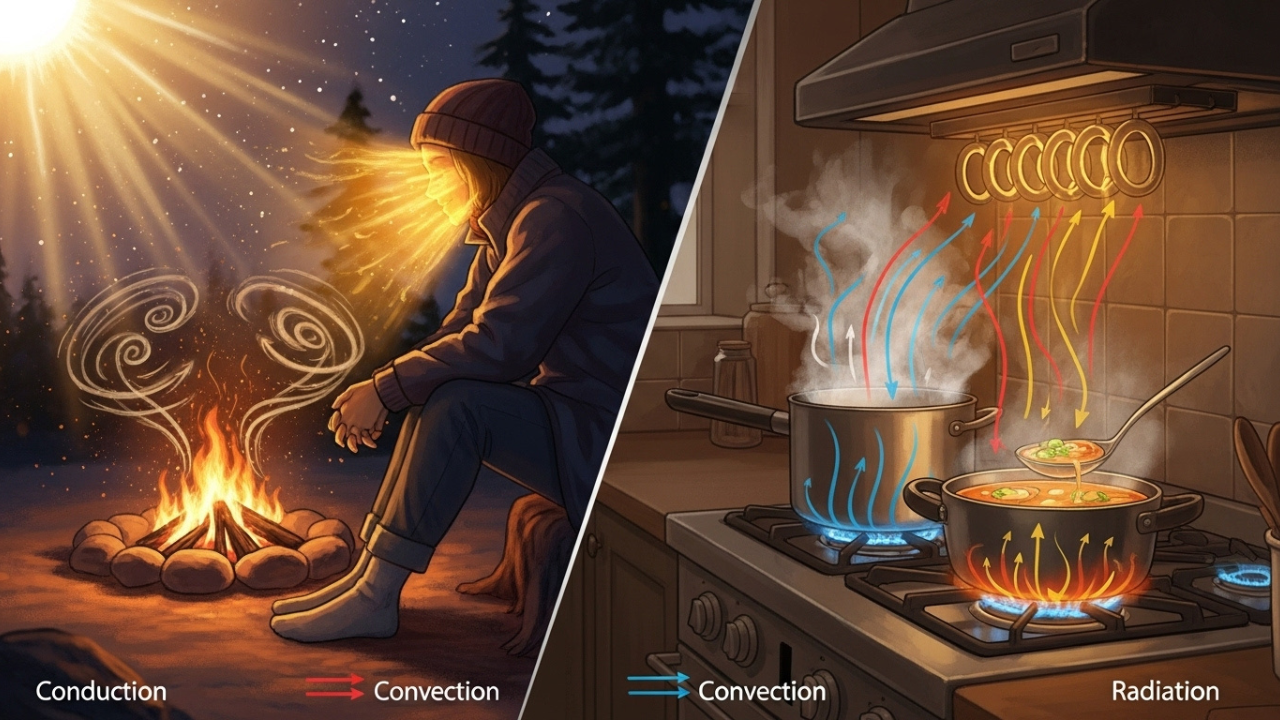Explorer, think backwards: when physically moving a heat, what comes to mind? It could be stepping in a car during the summer, it could be trying to lift a spoon out a pot cooking on the stove. Another case is standing near a bonfire and noticing that the air between you and the flames is still air yet warm of sorts. Heats are visually warm but also carry a lot of hidden complexity. All of these moments are breath taking yet relies on one theory, transfer of heat.
This process isn’t subjective in sight; it must always be guaranteed that the feeling is there alongside. There are three distinct ways via which heat could be transported.
Heat conducts, convects and radiates. It’s a guarantee that most of you have come across these terms at some point in school whether in form of flashcards, diagrams, or text books you were forced to read during detention. The aim here is not remember everything in as many ways possible.
The goal out there is merge your experiences with knowledge you already possess. Evaluating the interconnectedness between these forces and understanding their differences in movement is wholesome.
Key Takeaways
- Conduction is heat transfer through direct contact, as felt when you directly touch warm objects.
- Convection is heat transfer from moving air or liquid, like steam coming off surface of soup.
- Radiation is sending heat across empty space, such as how sunlight warms your skin.
- All three of these are used collectively in day-to-day activities, oftentimes unnoticed.
- Knowing how heat is transferred enables you to enhance comfort, safety, and energy efficiency.
Feeling Heat Before You Knew the Science
It typically begins out of nowhere. You grab something hot and you instantly retract your hand. Your skin seems to do something unusual before your brain can make out what’s taking place. Each of these actions, sensations, occurs in the blink of the eye and the moment you’ve experienced. Conduction. You have directly come into contact with an object that is at a temperature higher than your body.
At that instance, heat did enter your skin. It did not come haphazardly. It obeyed law- rules that govern every thermal energy movement, each increase in temperature, every warm wind or hot surface known to you. To familiarize oneself with these laws does not require a college degree; simply needs attention, retrospective, and a hint of intrigue, all of which, you possess.
Let me begin explaining without providing complex definitions but instead, through the instances and locations that are most familiar to you.
Conduction: The Heat You Feel When You Touch Something
You are now in the kitchen again. A spoon is waiting in soup. The soup is boiling, and the spoon is made of stainless steel.
You intend to give a stir as soon as you reach towards the spoon’s handle. Before you can grasp the handle, your palm must close around it, and at that point, it would be too hot to handle. The spoon’s handle has already heated due to the heat climbing from the bubbling soup’s surface, reaching the spoon’s diamond and metal body.” The entire journey described is conduction.
Conduction occurs when the transfer of heat is made through the solid materials. It neither jumps around nor flies.
It moves by touch, and so the movement occurs with one molecule that vibrates, which nudges the other, subsequently. The more they vibrate, the more energy they will handover.
Such materials include metal, and this type of movement occurs in them rapidly. That implies quick cooking due burning available to metals, and slow burning or little cooking for non metals like plastic or wood, as you are able to sense with even a light touch. You wish to touch, the wood or even plastic, and that’s when the difference is indeed palpable. The reason, the heat doesn’t travel as fast to those materials is due the inability to pass energy through.
The heating and cooling napkin ring and the metal bench are two objects that share the same space, but differ greatly in their properties. One of the objects burns as the other remains the same temperature which is in bearable limits. This signifies conduction in the real world, where one form of material changes the speed and strength of heat transfer.
Why Some Things Heat Faster Than Others
The plastic casing of a car key fob alongside the the key neatly placed in one’s pants pocket or purse is an ideal example. The day seems hot, and you pull them out all at once. The metal casing appears extremely hot.
But the casing feels just fine. During the key’s exposure to air, sun, and time, the same duration is exposed, but remains changed. The difference is key, while metal is awesome at transferring energy, it is not the same for plastics and rubber.
Public application of this key idea exist where cooking appliances or clothing material is and building construction is involved. Conduction is the what defines the existence of oven mitts. It is the reason firefighters wear thick clothing, use when insulating with electric wires. The finest example is the insulation wrapping over wires. Learning about solid structures articulate better the choice of holding, touching, and any other action before anything warm, it assists to have a better decision.
Convection: The Heat That Flows Through Fluids And Air
Now distance yourself from any tactile interaction. Imagine a soup in a pot simmers on the stove. You lean over and waves of warmth rising to your face with tendrils of vapor. Although you didn’t come in contact with the pot or the soup, you still perceive their heat. This phenomenon is termed convection.
One method would be to say how it transports power in liquids and gasses. As the bottom of the soup gets hotter, the liquid becomes lighter and rises to the top. On the other hand, cooler soup moves down to take its place. Essentially, there is a cycle- a steady rolling activity occurs where heat is not transferred from contact, but rather, by the motion of the substance. The same principle applies to air, warm air will rise while cooler air sinks. This is the way space heaters warm a room, how weather systems are formed, and how your food is evenly cooked in an oven.
Be rest assured, you have experienced convection without understanding the term itself. Each time you stand close to a fire, you observe the flames rising, curling, then dispersing. With convection, heat will be driven by alternating air pressure and temperature changes and spread upward and outward.
Convection In The Places You Least Expect It
If you sit near a window on a cold day, Ouch! Even when there’s sunshine outside, you will feel a chill creeping towards your toes. That air coming down the glass is cool. It is heavier, denser, and it indeed sinks. Air from inside the room moves upward to fill the space. Hey guess what? You’re caught in the middle of a convection loop. This same idea which powers air conditioning now home insulation and even the way birds glide with less effort using rising warm air.
Knowing Convex helps you notice when your environment isn’t working for you. If one room in your house is hotter than another, if your fan only cools part of the space, if your upstairs bedroom stays too warm, all of that can be traced back to how air moves, and how heat rides that motion. This should give you enough knowledge so you can do something to fix it.
Radiation: The Heat That Moves Through Empty Space
Step outside. The sunlight is above you. By just shutting your eyes, the heat envelops your face. At this moment, you are not in contact with anything. There is nothing blowing towards you, yet you still feel some form of heat, instant and everlasting. That is what is known as radiation, and it operates in a way that is different compared to all the others.
Heat can move without a medium through radiation. It doesn’t require contact or conduction, or air and water like convection. Heat is what the sun uses to warm the Earth, the fire uses to warm your skin, and the microwave you own uses to transform your food into a steaming delight. Even while feeling heat emanating from a brick wall long after the sun sets, that’s radiation.
From the areas you live in to the places you travel to, radiation is all around you. To many, a campfire is nothing but a way to socialize with friends, but in reality, it is the best example of heat being radiated by energy without contact. The toast being prepared in the kitchen also radiates heat, as does the infrared camera spotting you in the dark. All depend on radiation, the invisible channel through which heat flows towards you, the universe, regardless if there is nothing around.
Where Radiation Is Always At Work
Radiation is omnipresent, and its effects are boundless. As long as oxygen is available, the human body will radiate heat at all time. This will especially be useful while lying down on the floor or resting without a blanket on.
The reason you feel chilly even if the air is not cold is explained. Throughout the day, buildings absorb sunlight, which is released at night via radiation; this explains the reason cities are warmer after sunset. Stove coils, even if turned off, glow and radiate heat if they have been running long enough. That energy you see in the dark is not light but energy itself, still in motion.
Insulation deals with shading protection against solar heat; this combined with the effect the air temperature, wind speed, and outside temperature have on indoor window glass in conjunction with window glass type determines the insulation value. Once the insulator knows the laws of radiation, one knows how to control comfort by blocking, reflecting, or redirecting it as needed.
Heat Transfer Is Never Just One Thing
Heat transfer occurs in three forms simultaneously when you sit near a campfire. You are getting conduction on your feet as the ground is warm, while the warm air around your body is moving and carrying heat with convection. Direct warmth felt on the face is radiation. The combination of these forms creates a unified experience.
Integrating fuel physics with cooking offers another fascinating example. This is witnessed while baking a pizza in which the metal tray is placed in the oven. The ground convection cooks the toppings, while the radiant heat from spiraling coils of the oven bakes the crust. Understanding the different ways heat is transferred strengthen one’s cooking skills and enhances the ability to master the culinary art.
My Opinion
As an Explorer, understanding how heat moves encourages you to take command of your environment and surroundings. It allows you to stay warm without expending fuel, cool off without stressing the devices, and shield from harm or burns. You learn how to choose the best materials, design smart spaces, and prepare for the dynamic environment.
If you comprehend conduction, you know to grab a wooden spoon instead of a metal one. If you comprehend convection, you know to change the angle of your ceiling fan during winter. If radiation is your forte, you know that parking under a tree is more favorable. These statements are not just facts – they represent choices. Choices which stem from the understanding of the surroundings as well as the methods of heat transfer occurring in the vicinity.






























Leave a Reply
View Comments